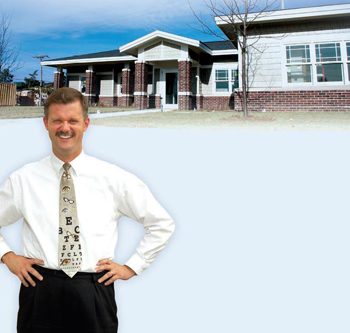 |
John Shepherd, M.D., director of the Weigel Williamson Center for Visual Rehabilitation, took a circuitous route to UNMC that helped him earn a true appreciation for what his patients go through. The new Weigel Williamson Center for Visual Rehabilitation will officially open its doors next Tuesday. |
John Shepherd, M.D., knows what it’s like to lose hope.
It was an experience that taught him empathy for people who live with chronic conditions, especially low vision.
As an ophthalmologist, life for Dr. Shepherd was good. He had been in private practice in Mankato, Minn., for three years, providing medical and surgical solutions to people with vision problems.
“I performed about five cataract surgeries every week, in addition to a variety of laser surgeries and minor procedures. I trained rural family practice residents to become familiar with problems of the eye through my clinical appointment with the University of Minnesota,” said Dr. Shepherd, who earned his medical degree from St. Louis University School of Medicine in 1990.
If there was a problem he could fix, he would. For patients beyond his help, well, there was nothing he could offer — at the time.
But then in 1997, a lower back injury started him on a journey that would take him around the country, and finally to Omaha.
|
Still, the back pain forced him to give up his surgical practice.
“I saw several doctors and nothing helped,” he said. “I was imprisoned by my back pain.”
An identity crisis set in.
“I became an ophthalmologist who couldn’t do surgeries,” he said. “I was a father who couldn’t play football with my kids, or pick up my youngest child. It made me sit back and look at the issues my patients face.”
He asked himself many questions.
“What happens when a physician runs out of options for patients? Are we taking care of the eye or the person? People still need to function and people who have low vision need rehabilitation, just as stroke victims do. The most vulnerable populations, the young, old and disabled, want options.”
A colleague suggested he look into developing a practice that helped people with low vision, but it took eight years before he took a class on the subject at the annual meeting of the American Academy of Ophthalmology.
That class opened a new window of opportunity for him. With no fellowship training available, Dr. Shepherd invented his own. His wife and six children stayed in Minnesota while he flew to San Francisco to work with ophthalmologist Don Fletcher, M.D., an expert in low vision rehabilitation at the California Pacific Medical Center.
Dr. Fletcher also sent him to train at other low vision centers in California, Michigan and Florida, all without pay.
“Low vision care is an entirely different type of practice,” Dr. Shepherd said. “It’s time intensive.”
Normally, an ophthalmologist spends limited amounts of time per patient on an eye exam. But, with low vision patients, a physician could spend up to two hours doing an exam and discussing issues and coping mechanisms.
“I came to realize that having low vision was an emotional and physical parallel with my back injury,” Dr. Shepherd said.
He found a desire to dedicate his whole career to this, but where?
His search finally led him to Omaha when he was introduced to Kathy VonDollen, coordinator of UNMC’s Low Vision Clinic, and Pat Jones, assistant coordinator, at a low vision meeting in Kansas City in 2006. It was an encounter that would give them all what they needed.
VonDollen and Jones wanted to expand UNMC’s 25-year-old clinic into a comprehensive vision rehabilitation service. The two were pursuing a dream they’ve had since 1998, the development of a low vision house on campus. But, they needed help and Dr. Shepherd was willing to consult on the project on a volunteer basis. Last fall, he was hired to be the center’s medical director and made assistant professor of ophthalmology.
“It’s amazing to see the heart and passion of these two women,” he said. “They have so much perseverance — they are making a dream become reality.”
Nearly 14 million Americans — about one in 20 people — have impaired vision. By 2020 this number is expected to increase by more than 60 percent.
“It was a mistake to not realize earlier that I could give patients hope and the ability to move forward,” he said.
The Weigel Williamson Center for Visual Rehabilitation is the first low vision house in the United States connected with a university medical center. It will be unique in many ways, Dr. Shepherd said.
The center will have three components: high and low technology devices to find out what works best for each individual; visual retraining to enable patients to use what vision they have more effectively; and recommendations for home modification to allow patients to better function.
Besides Dr. Shepherd, optometrists, Frank Graf, O.D., and Patti Fries, O.D., will provide services at the center. These eye care providers will concentrate on rehabilitative medical concepts. Unlike a traditional eye exam, the low vision exam will address functional problems as well as emotional issues. The physician, together with the patient, will set up a visual rehabilitation plan.
Vision rehabilitation training, provided by an occupational therapist, will be conducted in the center, where an office, kitchen, living room and bathroom have been adapted for low vision. When possible, the occupational therapist will help patients implement low vision modifications during a home visit.
Dr. Shepherd will be providing low vision training for ophthalmology residents. Also under consideration is the possibility of eye care providers outside UNMC being able to use the UNMC center to provide low vision services to their own patients, for a fee.
Reflecting on his journey, Dr. Shepherd, who can now pick up his 4-year-old daughter, is grateful.
“I feel blessed that I’m able to see the issues more clearly for low vision patients because of what I’ve been through,” he said.